Abramites eques
Scientific name: Abramites eques
Common name: N/A
Family: Anostomidae
Usual size in fish tanks: 12 - 15 cm (4.72 - 5.91 inch)
014
Recommended pH range: 6.5 - 7.2
Recommended water hardness: 4 - 16°N (71.43 - 285.71ppm)
0°C 32°F30°C 86°F
Recommended temperature range: 22 - 26 °C (71.6 - 78.8°F)
The way how these fish reproduce: Spawning
Where the species comes from: South America
Temperament to its own species: aggressive/territorial
Temperament toward other fish species: peaceful
Usual place in the tank: Middle levels
General Information
Abramites eques is a medium anostomid “headstander” that naturally swims at a slight head-down angle while browsing surfaces. It is native to north-western South America, with verified records from the Magdalena River basin in Colombia (not broadly Amazon–Orinoco as often repeated). Adult size in aquaria is typically 12–15 cm, while scientific maximums reach ~18.5 cm SL. Keep singly or in a well-sized group; in cramped quarters conspecific disputes are common.
Food & Feeding
A predominantly herbivorous/periphyton-grazing species. Make the staple high-quality algae/spirulina wafers and plant-rich flakes or soft sinking granules; rotate blanched greens (spinach, zucchini, peas). Offer small amounts of animal protein (daphnia, brine shrimp, bloodworms) as occasional supplements only. Expect vigorous grazing on tender plants—use tough, attached species for aquascapes.
Sexing
External dimorphism is modest; females are fuller-bodied when gravid. Venting is most reliable for certain sexing.
Breeding
Wild reports indicate distinct pairs spawning among dense vegetation/weeds, with no elaborate parental care. In the home aquarium, spontaneous breeding is unreported; commercial reproduction is not established for hobbyists. If attempting, use a large, well-oxygenated tank with seasonal cues and heavy plant cover.
Lifespan
With clean, stable water and a plant-forward diet, expect around 5–8 years (comparable to related headstanders).
Tank Requirements & Water Parameters
- Space: active, continuous grazer; plan for a long tank of 120 cm/4′ for a single or small group.
- Water: pH 6.5–7.2, hardness ~4–16 °dH, temperature 22–26 °C—stable, well-oxygenated, low-nitrate conditions.
- Flow & filtration: moderate current and strong biofiltration (riverine fish); provide high dissolved oxygen.
- Décor: sand/fine gravel with driftwood branches/roots and rock for biofilm; use robust, attached plants (e.g., Java fern, Anubias) to minimize leaf damage.
- Maintenance: frequent partial water changes and steady minerals to support gut health and grazing behavior.
Compatibility & Tank Mates
Peaceful toward other species of similar size, but can be territorial with conspecifics, especially in twos or cramped groups. Best kept singly or in a larger shoal (6–8 ) in ample space. Combine with robust characins, peaceful cichlids, and armored catfish; avoid delicate plants and bite-size nano fish. (Plant-nibbling is normal, not “bad behavior,” for this grazer.)
Behaviour & Usual Place in the Tank
Mid–lower levels: cruises at a head-down angle along wood and rock, browsing aufwuchs and algae. Provide open lanes between hardscape and shaded rests under branches.
Short Description
Abramites eques is a Colombian headstander evolved for constant grazing. Give it room, strong filtration and oxygenation, and a plant-based diet; expect conspecific pecking order dynamics and habitual head-down browsing.
Q&A
- Where is it actually from? Verified Magdalena River basin (Colombia), not broadly Amazon/Orinoco.
- How big does it get? Commonly 12–15 cm in aquaria; scientific maximum around 18.5 cm SL.
- Is it plant-safe? No—this is a grazer; expect nibbling. Use robust plants or hardscape-centric layouts.
- Can it be bred at home? No reliable home-aquarium reports; wild pairs spawn among dense weeds.
Picture
Bought by aqua-fish.net from jjphoto.dk.


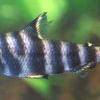 Marbled
Marbled 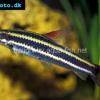 Striped
Striped 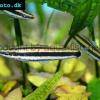 Goldstripe
Goldstripe 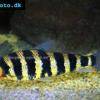 Headstander
Headstander 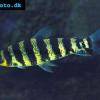 Black
Black